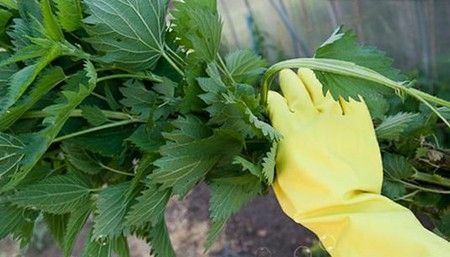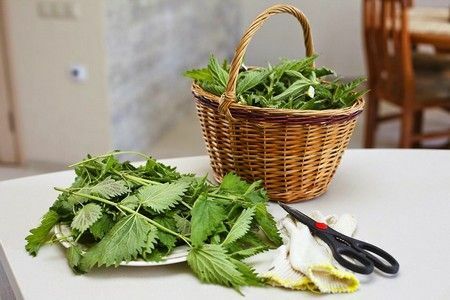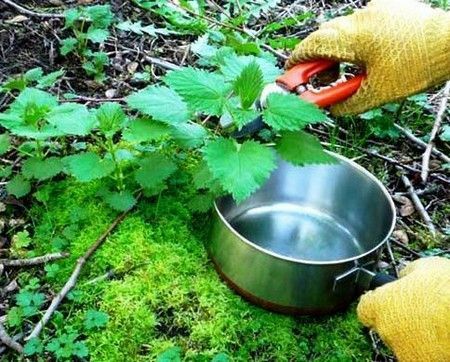- Collection of raw materials
- Drying of raw materials
- Storage rules
Leaves and seeds of nettle have been used for a long time both in folk medicine and in official pharmacology. Ready-made raw materials can be purchased at any pharmacy. But if you decided to do it yourself, then in this case you need to know: when to collect nettles, how to dry and store it. And today we will try to answer all these questions in the most detailed manner.

Collecting raw materials
Harvesting nettles for the winter is a painstaking work that will take time and, of course, some knowledge. If you do not have the latest, then the information below is sure to come in handy.
When to collect?
The medicinal substances are the most abundant in the aerial part of the plant - leaves and seeds. The leaves are considered suitable for harvesting during the full flowering period - in June-August - just at this time and it is necessary to collect nettles for drying.
The preparation of the aboveground part of the plant should be carried out in dry weather, it is best to do it at lunchtime so that the morning dew could dry out. If in the summer the plantings of nettle are subjected to mowing, then wait that in September its repeated flowering will come, and this will prolong the period of its harvesting.
Recommendation! If you plan to use nettles in fresh form, for example, for preparing dishes or cosmetics, then the collection of leaves can be done in early spring.
When to collect nettle seeds? This part of the plant must fully ripen. Seeding starts in August, and the duration of this process is about a month. In this case, make sure that the tops of the nettle completely fade.
Where to collect?
Although nettle is a fairly common plant and grows everywhere, it is forbidden to collect it for medical purposes in the following places:
- in close proximity to motorways and railways, since the plant will, during its development, absorb a large amount of harmful substances and, accordingly, the effect of its use will be directly opposed to the curative;
- not far from industrial plants, and also from their drains;
- near construction sites;
- near landfills;
- in the territory of abandoned farms, cattle cemeteries;
- near the storage of mineral fertilizers;
- in areas with elevated background radiation;
- in places where the sanitary and epidemiological situation is unfavorable.
Otherwise, the therapeutic effect will be minimal, and the risk of developing new diseases is maximal.
How to recognize raw material suitable for billet?
Before you prepare the nettle for the winter, pay attention to its appearance. A suitable plant has the following characteristics:
- leaves are clean and not contaminated with parasite precipitates;
- the above-ground part is not wrapped in a web;
- the surface of the sheet is flat, without inclusions;
- stalk is powerful with a lot of leaves;
- the plant has a uniform color.

How to collect?
Nettle - this is perhaps the only medicinal plant, the collection of which causes quite a lot of trouble. Burning stems and leaves do not allow you to touch yourself with your bare hands, so going for nettles, do not forget to take care of the presence of dense gloves.
The collection of leaves is carried out, not tearing them from the stem, as far as many do not have enough patience to pinch each leaf, sitting in an uncomfortable position, and even during the mosquito season. But at the same time, it is practically impossible to break the stem with your fingers - it begins to bend, crumble and soon turns into a loofah.

And when the leaves are slightly tied, they can be broken without problems and without gloves, as they lose their burning.
Important! Never pull the plant out of the ground with the root, as this will lead to the inevitable destruction of the thickets.
The leaves are cut off from the top of the stem, and only the tops are cut for seed preparation. For transportation, use baskets, paper bags or jute bags, but the leaves and seeds are not trampled in them, but are folded as loose as possible. Otherwise, the nettle can overheat, which will lead to the decomposition of useful substances in it.
Drying raw materials
Before drying the nettle, it must be quickly sorted out by removing other species of plants, earthen lumps and spoiled leaves. And only after this simple procedure the raw material can be dried.
Air Shadow Drying
This type of drying is ideal for the aerial part of nettle and includes the following parameters:
- choose a well-ventilated room or attic;in dry weather, this can be done outdoors by building a canopy;
- if drying is done indoors, the raw materials are best spread out on homemade shelves made from a rigid mesh or a dense gauze - thus free access of fresh air to the raw material will be ensured;
- when harvesting plants on the street, it is laid out a thin layer on paper or cloth and several times a day inverted;
Important! It is not recommended to dry the nettle by gathering it in bundles and hanging it on the walls, since in this case the air access to the leaves inside the bundle will be limited, and this will cause them to spoil.
- if drying is carried out on the street, then at night the plant is brought into the room and closes all the windows and doors.
Thermal artificial drying
For this type of drying, it is very important to choose the right temperature. In this case, we are dealing with leaves and seeds, for which the optimal temperature regime is from 50 ° C to 60 ° C.
If the farm does not have a special drying chamber, then the usual Russian oven will do. In this case, the temperature is checked as follows: throw a small piece of paper into the oven and if it does not begin to burn or yellow, you can safely send the nettle there. Drying in the oven also requires compliance with certain rules: the
- pipe can not be closed for the first two hours;
- flap must be installed on 2 bricks and leave its top edge slightly open.
Tip! If you do not have the opportunity to dry in the oven, you can use even the oven: lay the raw materials on a baking tray, set the minimum flame, set the heating regulator to "1" and leave the oven door ajar.
Signs of raw material readiness
- If the leaf is bent, its central vein will crack with a crash.
- The leaves have a deep dark green color.
- Surface rough to the touch.
- Characteristic herbal fragrance with hint of hay.
- Slightly bitter aftertaste.
Storage rules
Finished raw materials are laid in a clean and absolutely dry packaging:
- cloth bags;
- paper bags;
- cartons;
- boxes made of wood or plywood;
- glass jars.
Once the dried plant is laid, the container is tightly closed or tied and transferred to a cool place with good ventilation. If you plan to store nettles in bags, it is best to hang them on the walls, where they will be blown with air from all sides.
Shelf life of herbs should not exceed 1 year, in extreme cases - 1.5 years. Even if after this period nettle will look quite normal, it will not contain the necessary amount of useful substances. And in order not to forget, when it was made, stick a label with a date.
Be sure to pay attention to all our recommendations, and we guarantee that the time for harvesting nettles will not be wasted! Be healthy!
